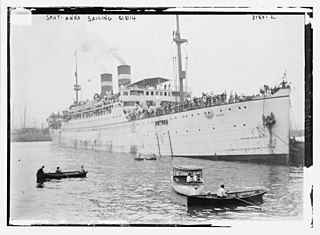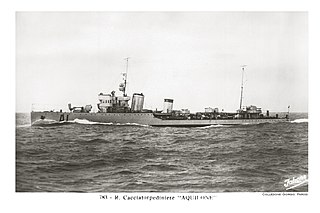
The Zara class was a group of four heavy cruisers built for the Italian Regia Marina in the late 1920s and the early 1930s. The class comprised the vessels Zara, Fiume, Gorizia, and Pola, the last of which was completed to a slightly different design. The ships were a substantial improvement over the preceding Trento-class cruisers, incorporating significantly heavier armor protection at the cost of the very high speed of the Trentos. They carried the same main battery of eight 203 mm (8.0 in) guns and had a maximum speed of 32 knots. Among the best-protected heavy cruisers built by any navy in the 1930s, the heavy armor was acquired only by violating the terms of the Washington Naval Treaty, which limited cruiser displacement to 10,000 long tons (10,160 t).

The Battle of the Mediterranean was the name given to the naval campaign fought in the Mediterranean Sea during World War II, from 10 June 1940 to 2 May 1945.

Trento was the first of two Trento-class cruisers; they were the first heavy cruisers built for the Italian Regia Marina. The ship was laid down in February 1925, launched in October 1927, and was commissioned in April 1929. Trento was very lightly armored, with only a 70 mm (2.8 in) thick armored belt, though she possessed a high speed and heavy main battery of eight 203 mm (8 in) guns. Though nominally built under the restrictions of the Washington Naval Treaty, the two cruisers significantly exceeded the displacement limits imposed by the treaty.

Bolzano was a unique heavy cruiser, sometimes considered to be a member of the Trento class, built for the Italian Regia Marina in the early 1930s, the last vessel of the type to be built by Italy. A modified version of the earlier Trento class, she had a heavier displacement, slightly shorter length, a newer model of 203 mm (8 in) gun, and a more powerful propulsion system, among other differences influenced by the Zara class that had followed the Trentos. Bolzano was built by the Gio. Ansaldo & C. between her keel laying in June 1930 and her commissioning in August 1933.

The First Battle of Sirte was fought between forces of the British Mediterranean Fleet and the Regia Marina during the Battle of the Mediterranean in the Second World War. The engagement took place on 17 December 1941, south-east of Malta, in the Gulf of Sirte. It was tactically inconclusive as both forces were limited by the strategic goal of protecting a convoy of their own and as such, neither were looking to force battle.

The Battle of the Duisburg Convoy was fought on the night of 8/9 November 1941 between an Italian convoy, its escorts and four British ships. The convoy was named BETA by the Italian naval authorities and carried supplies for the Italian Army civilian colonists and the Afrika Korps in Italian Libya.

The Battle of the Espero Convoy on 28 June 1940, was the first surface engagement between Italian and Allied warships of the Second World War. Three 36 kn Italian destroyers made a run from Taranto for Tobruk in Libya to transport Blackshirt anti-tank units, in case of an armoured attack from Egypt by the British.

Giuseppe Fioravanzo was an Italian admiral. He was considered one of the main "intellectuals" of the Regia Marina; together with admirals Bernotti and Di Giamberardino he was one of the main authors of the development of Italian naval doctrine between the two World Wars. After serving with distinction in the Italo-Turkish War and the First World War, from the 1920s he started his activity as a naval theorist and writer besides continuing his military career. During the Second World War, having been promoted to Divisional Admiral, he held important commitments, both operational and related to General Staff. After the war he directed the Historical Office of the Italian Navy for many years.

HMS Lively was an L-class destroyer of the Royal Navy. She served during the Second World War, and was sunk in the Mediterranean in an air attack on 11 May 1942.

Albatros was a submarine chaser of the Regia Marina built in the 1930s which served during World War II. Later she was reclassified as a torpedo boat, most likely purely for administrative purposes.

SS Sant′ Anna was a transatlantic ocean liner converted into a troopship in 1915, torpedoed and sunk in the Mediterranean Sea on 11 May 1918 with 605 casualties.

Ascari was one of nineteen Soldati-class destroyers built for the Regia Marina in the late 1930s and early 1940s. Completed in mid-1939, she was the last of the first batch of a dozen ships to enter service.

Ostro was one of eight Turbine-class destroyers built for the Regia Marina during the 1920s. She was named after a southerly wind, Ostro, common in the Mediterranean and Adriatic. The ship played a minor role in the Spanish Civil War of 1936–1937, supporting the Nationalists.

Borea was one of eight Turbine-class destroyers built for the Regia Marina during the late 1920s. She was named after a northerly wind, Borea, bringing frigid, dry air to the Italian peninsula. The ship played a minor role in the Spanish Civil War of 1936–1937, supporting the Nationalists.

Zeffiro was one of eight Turbine-class destroyer built for the Regia Marina during the 1920s. She was named after a westerly wind, Zeffiro, common in summer in the Mediterranean. The ship played a minor role in the Spanish Civil War of 1936–1937, supporting the Nationalists.

Turbine was the lead ship of her class of eight destroyers built for the Regia Marina during the 1920s. Her name means whirlwind.

Aquilone was one of eight Turbine-class destroyers built for the Regia Marina during the late 1920s. She was named after Aquilone, a cold northerly wind.

Freccia was the lead ship of her class of four destroyers built for the Regia Marina in the early 1930s. Completed in 1931, she served in World War II and previous conflicts.

Pegaso was a torpedo boat and an escort aviso of the Italian Regia Marina. She was one of the most successful Axis anti-submarine warships of World War II.

Fulmine ("Lightning") was the Kingdom of Italy′s first destroyer. Commissioned into service in the Italian Regia Marina in 1900, she served in the Italo-Turkish War and World War I. She was stricken in 1921 and scrapped.



















